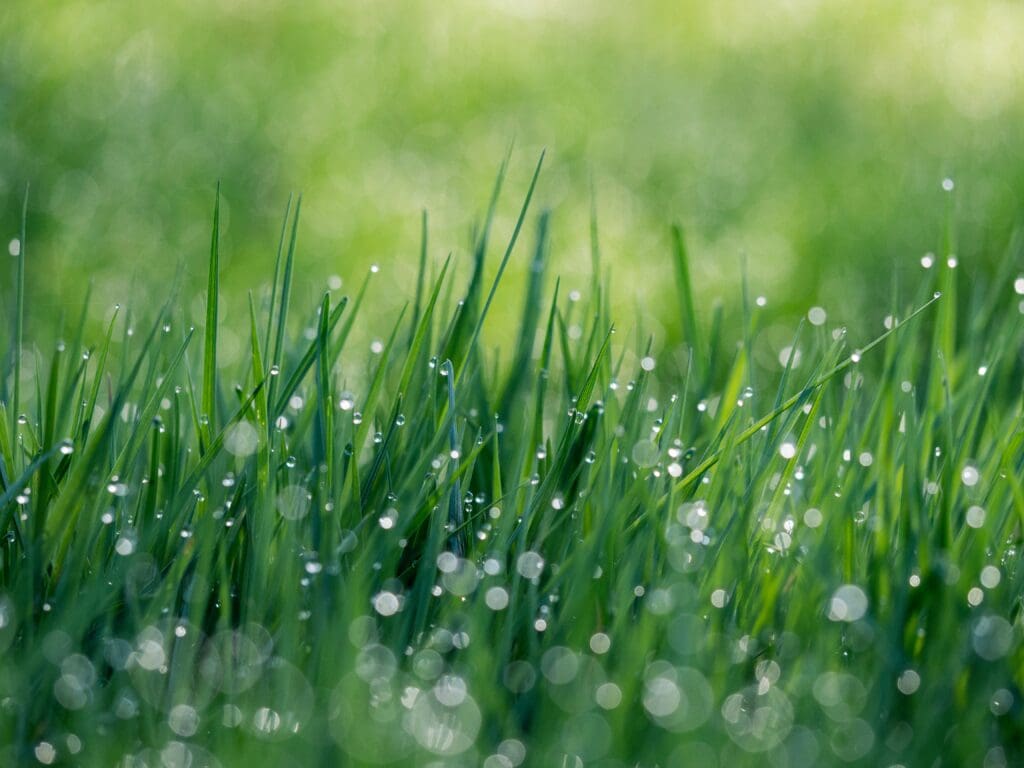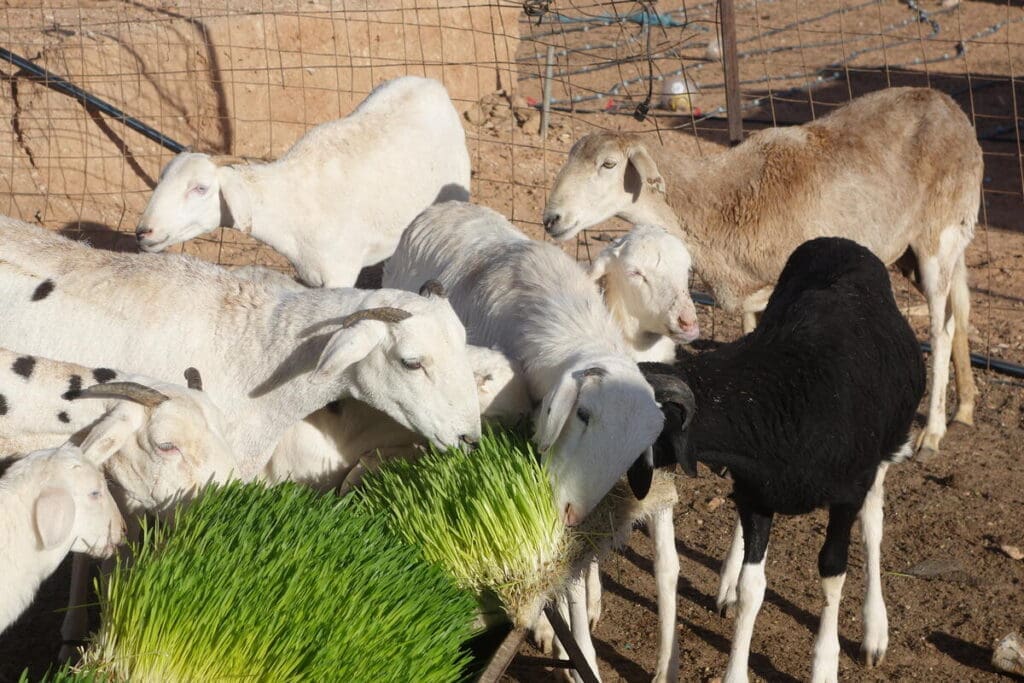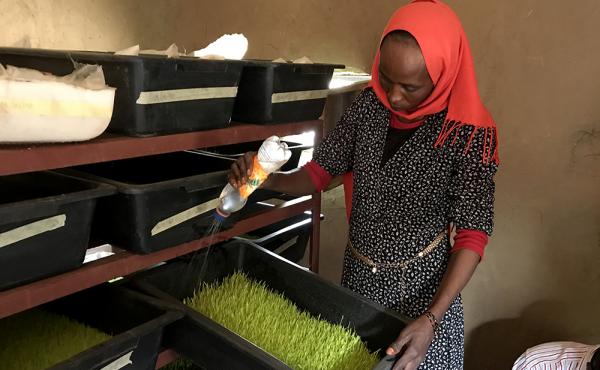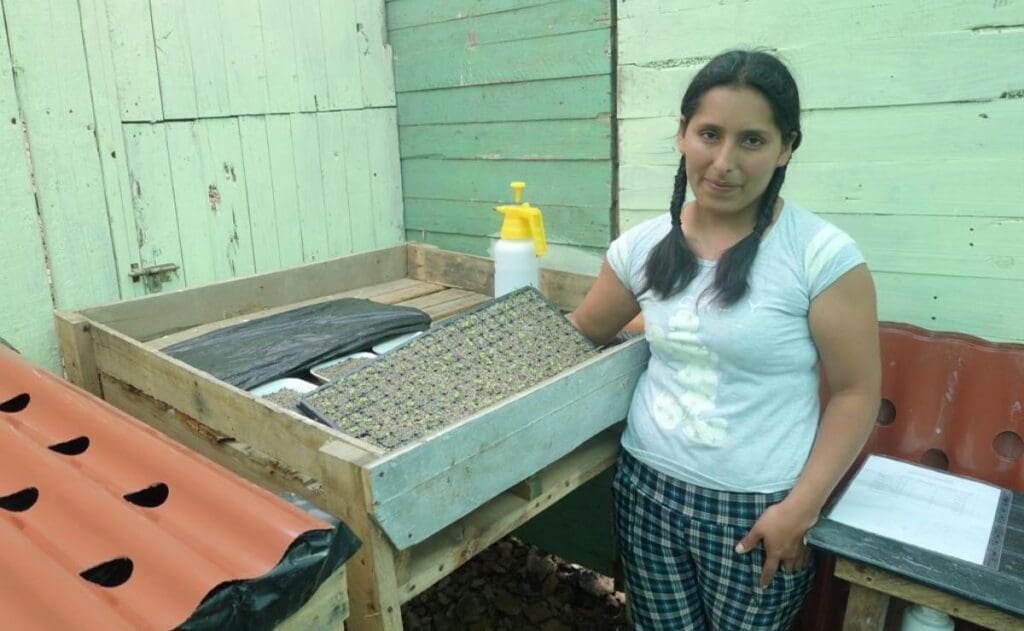How to Grow Goat Food in the Sahara, Barley in Refugee Camps & Veggies in Desert Slums

April 28th is World Day for Safety and Health at Work! The COVID-19 pandemic has impacted nearly every part of the workplace, from social distancing measures to wearing protective equipment like gloves and masks. The health crisis has also driven millions into hunger and poverty, and compounded the ongoing effects of conflict and climate change for vulnerable populations.
Today, we recognize the resilient communities around the world who are overcoming the ravages of war and hunger through innovation. Read on to learn how the simple, sustainable technique of hydroponics – the science of growing plants with just water – is improving two- and four-legged lives in some of the toughest places in the world.
~
Fresh, green barley grass sprouts in the deserts of Algeria and Chad, where refugees fleeing conflict have struggled to find and grow food. In Peru, women tend to colorful, thriving vegetables in the crowded desert slums of Lima. All this new life is thanks to H2Grow, the United Nations World Food Programme’s (WFP) ongoing hydroponics project, which helps communities facing conflict and poverty build and sustain their own hydroponic crop systems. It’s all about growing green in the most impossible places.
Hydro-what?
Growing hydroponically means skipping soil, instead bathing plant roots in a perfectly engineered cocktail of nutrient-rich water. This soilless cultivation technique means food can grow anywhere in the world, any time of year – on arid, non-fertile land for example, or in urban spots with limited space.
The systems use nearly 90% less water than traditional agriculture that can be filtered and fed back to plants again and again. And hydro-grown plants mature up to 25 percent faster than soil-grown plants while requiring fewer resources.
Hydroponics are proving wildly helpful in places where supplies are scarce, the land is unforgiving and people are most vulnerable. These places are overwhelmingly in conflict zones. For example, conflict, violence, persecution and human rights violations have driven more than 79.5 million people from their homes, including 45.7 million internally displaced persons and 26 million refugees. Hydroponics are a perfect match for the harsh environments where so many of these refugees have landed.
Growing Goat Food in the Sahara
Deep in the Sahara desert, home to the tens of thousands of Sahrawi refugees who fled conflict in Western Sahara, H2Grow is using low-tech hydroponic units to help the long-displaced community grow barley grass for their animals.
Algeria has hosted the refugees since 1975, in what’s become one of the world’s most protracted refugee crises. The Sahrawi contend with a harsh and isolated desert environment, and face high levels of chronic malnutrition. The traditionally nomadic community values livestock for milk and meat.
“But as they themselves are completely dependent on food aid, they very rarely have the means to actually feed their animals,” said Nina Schroeder, project manager at the U.N. World Food Programme’s Innovation Accelerator. “The animals actually end up eating garbage, leading to very poor nutritional value of the meat and milk they produce.”

Sahrawi refugees’ animals now eat the barley grown in hydroponic production units.
Now, in just seven days, fresh barley grass can be grown from seed using very little water and no fertilizer. We installed more than 150 hydroponic units that now produce more than 4,400 pounds of sprouts per day, with one unit feeding around 20 animals and supporting up to seven families. The goats fed with fresh grass increased their milk production by a whopping 250%, and meat quality and quantity improved considerably. Even more, refugees with hydroponics were able to sell off their surplus grasses for a little extra income – a great benefit in conflict zones where displaced people often struggle to find work.
Azuha, a 25-year-old mother, was one of the first people to benefit from the project in the Dakhla camp. After an introductory training, she’s growing plenty of barley and maintaining her own unit, protecting it from wind, sandstorms and keeping it cool from the sun. Her goats are much happier and healthier as a result.
Over sixty percent of the world’s hungriest people, like Azuha, live in conflict zones. Thankfully, low-cost hydroponic models can easily be scaled up and replicated in conflict zones and other environmentally vulnerable places.
…Like in Eastern Chad
When we met her, Arafa had lived in the Touloum refugee camp in Eastern Chad for 14 years, forced from her home by ongoing conflict. She relied on her livestock to feed her children and her elderly parents. But just like Azuha in Algeria, her animals were feeding off garbage, making for poor quality milk and meat.
Eastern Chad is home to more than 300,000 refugees like Arafa who’ve fled violence in Sudan’s Darfur region. Most live in extremely harsh conditions in camps along the border, exposed to long-lasting droughts and unpredictable rainfall that make growing food and caring for animals nearly impossible. Communities there face some of the highest malnutrition rates in the world.

A group of women in Chad show off their freshly grown grass.
We worked with Chadian innovators to set up hydroponic systems in the camps to grow fresh grass with the same aim (and in nearly the same conditions) as the Sahrawi refugees: to increase the production of milk and meat and improve nutrition.
Arafa is already growing fresh grass, helping keep her goats healthy and providing more – and better – quality milk to her family as she works towards self reliance.

With our help, Arafa built her own hydroponic units using local materials.
A Sea of Sand in Peru
When Merly and her family left their home in the Andes to find work in Lima, she struggled to find nutritious food for her children. She was used to the fertile lands of her hometown, and the city’s crowded desert slums proved unforgiving.
“When I arrived in Lima, I was expecting to find luscious green fields,” said Nina Shroeder of the U.N. World Food Programme’s Innovation Accelerator. “To my surprise, all I saw was a sea of sand. No running water. No wells. Nothing green here. An impossible place, yet home for 3 million people.”
Lima is known as the culinary capital of South America, boasting some of the world’s most celebrated chefs. Peru is a major exporter of fruits and vegetables, but nutritious food is hard to find in Lima’s urban slums, water is scarce and thousands suffer from malnutrition.
Eager to provide a better future for her kids, Merly was one of the first entrepreneurs in Lima to give hydroponic growing a chance. In 2016, she worked with the U.N. World Food Programme and local innovators to create urban gardens, which grew quickly in the hands of many eager entrepreneurs.
Our pilot in Lima provided more than 200 vulnerable women with the tools to grow their own food.

The community has enough crops to feed their families and enough surplus veggies to sell and increase their income.
Now, we’re scaling up to find sales and distribution channels for their crops. We’re even developing a basic smartphone app with step-by-step tutorials, advice and access to experts as part of the H2Grow platform.

We trained community members, Merly included, as “hydroponic coaches,” making sure the tools and knowledge would spread.
In the meantime, Merly remains part of our H2Grow revolution, sharing the value of hydroponic growing with her community as a coach and educator.
Hydroponic Self Reliance
As we teach and promote hydroponics technology around the world, we’re able to help diversify and improve a community’s diet – animals included. New innovations like these have the potential to transform the lives of vulnerable populations across the world, helping them contend with conflict, climate change and poverty.
The people we serve – in places like Algeria, Chad, Peru and beyond – face challenges that require thoughtful, locally focused innovation. Our H2Grow movement has helped some of the most vulnerable people, in the most severe, unforgiving landscapes, grow life-giving green.
~
The U.N. World Food Programme was honored with the 2020 Nobel Peace Prize for its efforts to combat hunger, to improve conditions for peace in conflict zones and to prevent the use of hunger as a weapon of war. Hydroponics are just one of the many ways we help people weather the storms of war. To learn more, visit our Conflict and Hunger center.




